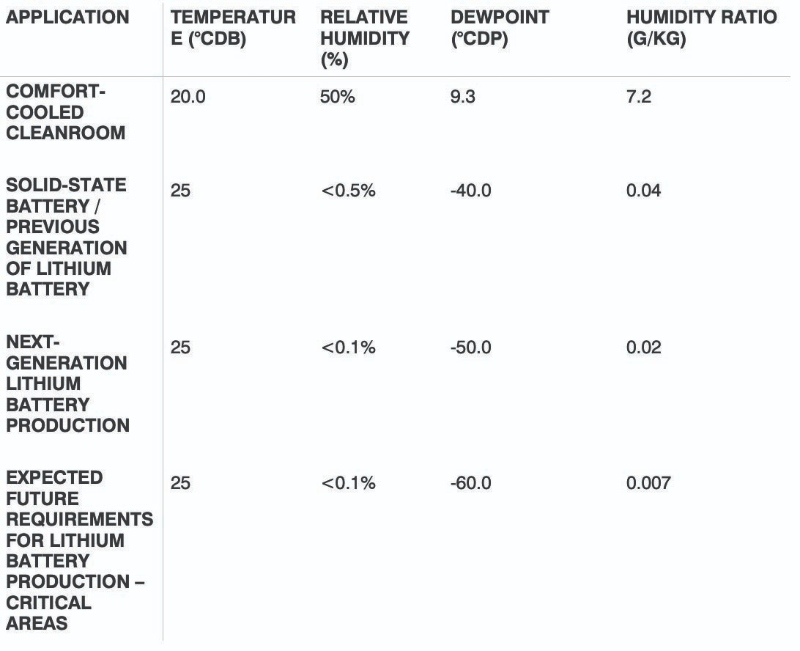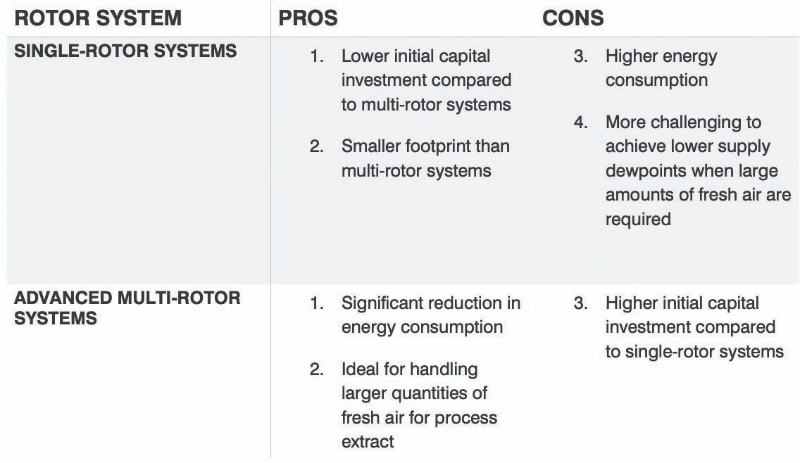Humidity control is critical in battery dry rooms as various materials and processes used in battery production are susceptible to moisture damage.
A low dewpoint air supply will mitigate the risks by creating a stable production environment suitable for the materials and processes. But what is a dry room? And how can the low dewpoint be sustained?
This article examines these questions and looks to provide the answers.
What is a dry room?
A dry room is a specialist production area that uses industrial dehumidification systems to maintain the air within the controlled space at low dewpoints (dp). Controlling humidity allows manufacturing processes or research primarily using hygroscopic (moisture-sensitive) materials.
Typically, in a dry room, the air is maintained at or below minus 30.0°Cdp, equivalent to less than 1% relative humidity (RH) at a typical room temperature of 22.0°C dry bulb (db). The continuous supply of ultra-dry air is essential to maintain the optimal environment for operations such as battery production.
Horizontal laminar flow systems are typically found in small-scale research facilities, whereas hybrid plenum designs tend to be used in larger-scale facilities
An ultra-low humidity room gives a consistent environment to investigate issues and produce a stable baseline for sensitive materials and processes. Within R&D applications, a dry room can help to determine whether it is the synthesis of the materials or the deposition processes that causes defects.
General benefits of controlling humidity levels:
- Lowers the risk of electronic failures through moisture damage
- Protects materials from corrosion or damage caused by sensitivity to high relative humidity
- Prevents the degradation of hygroscopic materials
- Reduces bacterial growth
What is dew point?
Dew point (dp) is the temperature that a volume of air reaches when it becomes saturated with water vapour, causing dew to form. It is a standard parameter to determine humidity control in an environment like a dry room.
Dry room specifications
To demonstrate how ultra-dry the air is in a dry room, let's compare it to the dew point in a typical environment. 20°Cdb and 50% RH provide comfort cooling, which translates to approximately 9.3°Cdp.
Now let's look at the requirements for battery production, which is a typical use of a dry room. Because of the material sensitivity, solid-state battery dry rooms may need humidity controlling to minus 40.0°Cdp at the point of return. Furthermore, dry rooms for lithium batteries need a greater humidity control of around minus 50.0°Cdp at the point of return.
The battery chemistry of the next generation of lithium batteries may have even tighter requirements. The specification could reach minus 80.0°Cdp at the point of supply into critical areas, such as Electrolyte Fill.

The examples in Table 1 illustrate a vast difference between the requirements of a typical environment and an application that needs a dry room. The conditions for a dry room are produced using a combination of HVAC design, an airtight envelope system, and process controls.
Dry room construction
Various stages within the production lifecycle need a dry room — from small-scale research units to giga-factories.

There is no one way to build a dry room, and the perfect specification will depend on individual requirements. The following factors will need consideration:
Footprint & zones - Establish a suitable layout for your process, featuring multiple zones, each with the optimum dew point temperature and ISO class
Dehumidification systems - Single or multi-rotor low dewpoint air handling unit (AHU) options to suit your budget, space, and specification needs
Internal airflow distribution methods - Horizontal unidirectional airflow with a supply and return air plenum or a high-level distribution system with uni or non-unidirectional airflow
Airflow modelling - Using Computational fluid dynamics (CFD) studies to verify HVAC design with equipment and furniture layouts
Scalable HVAC designs - With specialist AHUs designed for deployment in battery facilities, airflows range from 2,000 m³h to 50,000 m³h
Energy-efficient design - Airtight envelope systems and recirculated air manage energy efficiency
HVAC design - With energy prices escalating to new highs, HVAC running costs are an essential focus. Traditional low dewpoint air handling systems use a single desiccant rotor at the heart of the AHU. These systems have high energy requirements and contribute to a large proportion of the facility's running costs.
Principle of operation of a single rotor low dewpoint AHU
Low dewpoint AHUs vary from standard industrial desiccant dehumidifiers that can maintain air down to minus 20.0°Cdb dew point.
The incoming fresh air used for reactivation and process extract purposes must first be pre-cooled to between 2-4°Cdp to reduce the moisture load on the desiccant rotor. The cooled incoming air is mixed with the room's dry return air stream.
This combined air is then split between the process and purge sector (heat recovery) of the rotor. The purge sector is used for two purposes. The first is to improve system efficiency by removing the sensible heat gains from the regeneration process. The second is to bring the silica gel material into its optimal adsorption range, which maximises the efficiency of the available surface area of the process sector.
With energy prices escalating to new highs, HVAC running costs are an essential focus
Typically, the purge sector can recover 33% of the reactivation energy that would have otherwise transferred into the process air stream. The reactivation (regeneration) sector uses a range of mediums to heat the reactivation air. Temperatures of up to 140.0°Cdb are required to break the bond between the moisture vapour and the silica gel material. The final temperature and quantity of this heated air will determine the amount of moisture vapour removed from the rotor. The separated moist air is referred to as the wet air stream.
Typically the wet air stream of a low dewpoint system will be in the region of 50.0°Cdb and be discharged to the atmosphere. The traditional type of single rotor system can produce air at minus 60.0Cdp at the point of supply (Subject to levels of fresh air pre-cooling and return air condition)
Principle of operation of a dual rotor low dewpoint AHU
Multi-rotor systems have been developed in response to ever-rising energy costs. Like the single-rotor variant, the multi-rotor systems have the same method of operation.
However, these systems use a second desiccant rotor after the fresh air pre-cooler. Using the relatively warm and dry air from the primary rotor, the desiccant rotor on the fresh air inlet can further reduce the fresh air to as low as minus 20°C dewpoint while only requiring pre-cooling the incoming air to 10.0°Cdp.
This results in a vastly reduced chilled water (CHW) requirement, allowing the CHW system to run at a more efficient temperature. As the combined fresh air and reactivation airstream is now at a much lower dewpoint, the main rotor can reduce the supply dewpoint further and with less reactivation airflow and energy levels. Dual rotor systems can reduce supply dewpoints to minus 80.0°Cdp while requiring up to 35% less reactivation energy and up to 50% less CHW than the market-leading single rotor technology.

Internal airflow distribution methods
There are various options for the distribution of air in dry room facilities. Horizontal laminar flow systems are typically found in small-scale research facilities, whereas hybrid plenum designs tend to be used in larger-scale facilities.
Hybrid plenum designs feature a mixture of FFU and terminal HEPA filters with either low-level or floor-return air grills. Services can run within plenum areas, allowing for a cleaner internal finish
Envelope system
The envelope is an important part of a dehumidification system to achieve an energy-efficient dry room. A fully-sealed panel system with multistage airlocks and hermetically sealed doors will insulate the dry room and protect it from moisture ingress.
An ideal envelope system features low air leakage rates (with an overall infiltration target of less than 0.1m³/m²/hr), prefabricated panels for housing services, and walkable ceilings and access routes to main plant decks. The infiltration targets are a vital feature of dry rooms as it would be uneconomical to operate at dewpoints of minus 40°Cdp and below if you are working above 0.1m³/m²/hr. For comparison, a typical well-constructed cold store will achieve 0.3 m³/m²/hr.
As well as hermetically sealed doors, a pressure cascade regime via an airlock arrangement will minimise the effect of door usage. You will need interlocked airlocks if a facility features a rapid roller door. Pressure cascades further reduce infiltration, with critical areas maintained at 65Pa with specially designed shrouds located at exit points to create a curtain of dry air that helps reduce moisture transfer during door opening.
Internal detailing is crucial in achieving low infiltration rates by creating multiple sealing points
Internal detailing is crucial in achieving low infiltration rates by creating multiple sealing points. For instance, a vapour-proof barrier underneath flooring can improve air leakage rates, as can floor and ceiling coving sealed with cleanroom sealant. Due to the low humidity levels, walls and floors should have static dissipation properties and be bonded to earth.
Battery dry room manufacturers
As battery dry room facility manufacturers, Angstrom Technology deliver complete dry room systems. We provide bespoke solutions that include industry-leading energy-efficient HVAC systems.
Lithium battery dry rooms require specialist desiccant dehumidifiers capable of producing ultra-low dewpoint air as low as minus 80.0°Cdp. Working with our industry partner, DRYAIR (dry-air.co.uk), our lithium battery dry room systems can efficiently achieve these requirements.
DRYAIR and DT Group deliver 5000-50,000 m3h rated multi-rotor, ultra-low dewpoint systems in a single piece, resulting in a reducing site installation time and risk. The new generation of DT-LP multi-rotor systems has led to a 30-40% reduction in footprint (dependent on final configuration).





